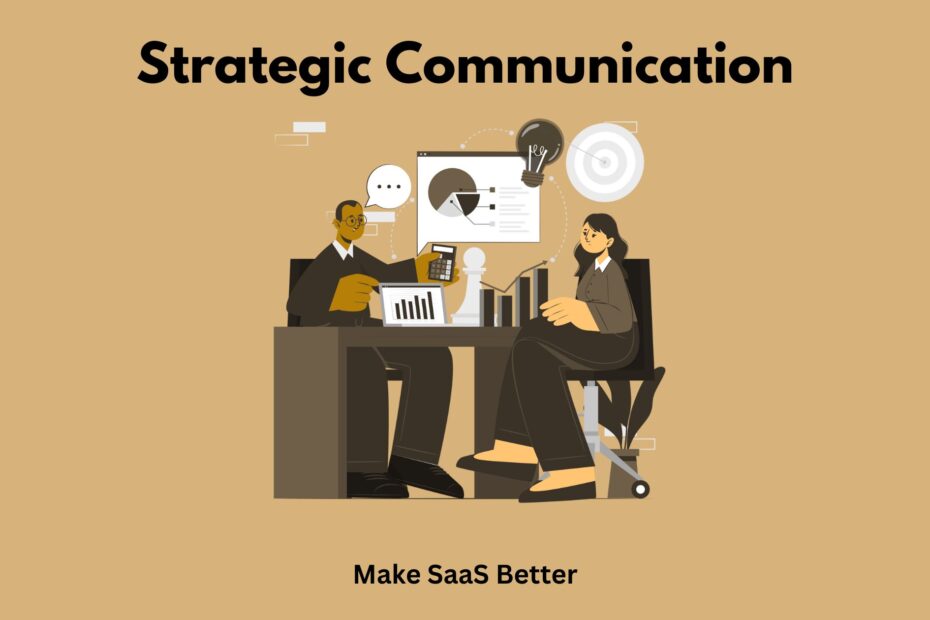The world moves fast. Information explodes. Every second, new data, new opinions, new demands. If you can’t cut through that noise, you’re irrelevant. It’s not about talking more. It’s about talking smarter.
A recent study found that 79% of customers expect a unified experience across all departments, yet a disheartening 55% feel like they’re talking to multiple separate groups, not one company. Fail that, and you’re just another forgotten name.
Internally? Miscommunication costs American businesses a staggering $1.2 trillion each year. That’s not a typo. $1.2 TRILLION. Companies that get communication right, however, enjoy 4.5 times higher employee retention.
People stay when they understand. They commit when they feel part of something. This isn’t soft stuff. It’s the hard truth of modern business. It’s about being precise. Being intentional. This is strategic communication.
What Is Strategic Communication?
Strategic communication isn’t accidental. It’s not just “getting the word out.” It’s a calculated act. It’s the intentional process of crafting and delivering messages to achieve specific, predefined objectives. Think of it like this: you have a target. A goal. Maybe it’s to sell a product. Maybe it’s to shift public opinion. Maybe it’s to rally your team.
Strategic communication is the detailed map and the precise execution to hit that target. It means knowing exactly who you’re talking to, what you want them to feel, think, or do, and then selecting the most effective way to reach them. It’s cyclical. You plan, you act, you measure, you adjust.
This field has grown far beyond simple public relations. It now covers everything from marketing campaigns to internal corporate messaging, investor relations, and even crisis response. Every single piece of information, whether sent out or shared within, aligns with the core purpose. It’s communication with a purpose.
Importance of Strategic Communication
Why does any of this matter? Because communication is the unseen architecture of success. It builds trust. When your messages are clear, consistent, and honest, people believe you. This isn’t just about customers. It’s about your employees, your investors, your partners. Good communication builds loyalty. It boosts morale.
Employees who feel informed, who understand the bigger picture, are more engaged. They work harder. They stay longer. It helps you hit your goals. Every well-placed message becomes a step toward your desired outcome. Imagine trying to build a business without everyone knowing the plan. Disaster. It also protects your reputation. When things go wrong – and they will – your communication strategy determines if you sink or swim.
In a world awash with instant feedback, a plan for what you say and how is your armor. In short, it’s not an option. It’s fundamental. The risk of a communication breakdown is too high to ignore. A single misunderstanding, a piece of information lost in translation, or a misaligned message can derail even the best-laid plans. This is why mastering communication, particularly strategic communication, is non-negotiable.
Types of Strategic Communication
1. Verbal Communication

This is the spoken word. It’s meetings, presentations, one-on-one talks, and phone calls. It’s immediate. You get real-time reactions. The power here is human connection. Your tone, your pace, your body language – they add layers to the message. A calm, steady voice in a crisis is more reassuring than frantic shouts.
A well-delivered presentation can persuade where a flat email fails. It’s about presence. This includes oral communication, where the immediacy of direct speech allows for nuanced interactions, questions, and immediate feedback, fostering deeper understanding and connection.
2. Written Communication

This covers anything put into text. Emails, reports, social media updates, press releases, blog posts. Its advantage? Permanence. It creates a record. People can refer back to it. It’s good for complex details or instructions.
But precision is key. Without the nuance of voice, words can be misread. A poorly worded email can cause massive headaches. Clarity and conciseness are non-negotiable here.
3. Visual Communication

Images. Videos. Graphics. Infographics. Design. This is communication that hits you without words. Your brand’s logo. The colors on your website. A powerful photograph. Visuals grab attention faster than text. They convey emotion. They simplify complex data.
Think about how a simple chart can explain a trend in seconds. Visual communication isn’t just pretty. It’s powerful. It creates an instant impression.
4. Digital Communication

This encompasses all forms of electronic communication, from websites and apps to social media and online advertising. It’s about leveraging technology to reach audiences instantly, globally, and interactively.
The beauty of digital communication lies in its reach and its measurability, allowing for instant feedback and rapid iteration, but it also demands constant vigilance against misinformation and the ever-present threat of noise.
5. Internal Communication

These are messages within an organization. It’s for your team. It keeps employees informed, motivated, and aligned. This includes company updates, policy changes, mission statements, and employee recognition.
A recent survey found that companies with effective internal communication see a 25% higher productivity rate. When your team knows the mission and their part in it, they perform better. It builds culture. This is also a critical component of corporate communication, ensuring that the vision, values, and strategic goals are clearly articulated and understood throughout the organization.
6. External Communication

This is communication to the outside world. Customers, investors, the media, and the public. It includes marketing, advertising, public relations, and sales communication. This shapes public perception. It drives sales. It builds your brand’s reputation. Every advertisement, every press release, every customer service interaction is external communication. It’s your public face.
A significant part of this is marketing communication, which is specifically designed to promote products, services, or brands to target audiences, aiming to influence purchasing decisions and build brand equity.
7. Crisis Communication

This is the emergency response plan. When something bad happens – a product recall, a scandal, an unexpected downturn – you need to speak. Crisis communication is about managing the narrative. It’s about honesty, speed, and showing control.
The goal is to limit damage, protect reputation, and maintain trust. A well-handled crisis can strengthen a brand. A poorly handled one can sink it.
Key Skills and Techniques in Strategic Communication
1. Clear and Concise Messaging
No fluff. No jargon. Get to the point. Most people scan, they don’t read. If your message is buried, it’s lost. Use simple words. Short sentences. Each word should earn its place. This isn’t just about brevity; it’s about impact. A confused mind does nothing.
2. Audience Understanding
Who are you talking to? Seriously. Not just demographics, but their values, their concerns, their desires. What do they already know? What do they need to hear? Tailor your message to their world, not yours. A message for potential investors differs greatly from one for frontline staff. Empathy is the foundation.
3. Active Listening
Communication is a two-way street. Active listening means truly hearing. Not just waiting for your turn to speak. It means asking clarifying questions. Observing body language. It’s about absorbing and understanding, not just processing. This builds rapport and shows respect. It also gives you vital information to adjust your message.
4. Storytelling
Facts are data points. Stories are experiences. Humans are wired for stories. They remember them. They connect emotionally. Use narratives to explain complex ideas, to show impact, to create a shared vision. A good story makes your message sticky. It transforms information into inspiration.
5. Channel Selection
Where does your audience live? Are they on LinkedIn, Instagram, or email? Do they read print or watch videos? The platform shapes the message. Sending an official policy update via TikTok is usually a bad idea. Choosing the right channel means your message reaches its intended recipient.
6. Adaptability
The world shifts. Your audience changes. New information emerges. Your communication strategy must be flexible. What worked yesterday might fail tomorrow. Being rigid means falling behind. Stay open to new ideas, new data, and new ways of connecting. Pivot when needed.
Common Challenges in Strategic Communication
1. Information Overload
Everyone is drowning in data. Emails, notifications, social feeds. Your message is one drop in an ocean. Getting noticed is hard. Being remembered is harder. The challenge is to be compelling enough to cut through the noise.
2. Lack of Clarity
Vague language. Jargon. Poorly structured thoughts. This leads to misunderstandings, errors, and wasted time. If your message isn’t crystal clear, it’s useless. Many people think they are clear, but few are.
3. Inconsistent Messaging
Different departments are saying different things. Contradictory public statements. This erodes trust. It makes your brand look disorganized, even untrustworthy. Maintaining a single, consistent voice across all touchpoints is a constant battle.
This often contributes to a communication breakdown, where inconsistencies lead to confusion and a loss of confidence among stakeholders.
4. Resistance to Change
People resist change. It’s human nature. Even when the change is good. Your strategic communication might be about new policies, new products, or new directions. You’ll face pushback. The challenge is to frame the message to address fears and show benefits.
5. Measuring Impact
Did your communication work? This is often hard to quantify. Did the email increase engagement? Did the campaign shift perception? You can send messages, but proving their effect requires solid metrics and analysis. Without measurement, it’s just guesswork.
6. Siloed Communication
Departments are acting like separate companies. Marketing doesn’t talk to sales. HR doesn’t talk to product development. This creates communication gaps internally. Information doesn’t flow freely. Messages get distorted or lost. Breaking down these internal walls is a huge challenge. This is a prime example of where a communication breakdown can occur, hindering collaboration and efficiency.
Best Practices for Effective Strategic Communication
1. Define Clear Goals
Start with the end in mind. What do you want your audience to do, think, or feel after receiving your message? Be specific. “Increase brand awareness by 15%.” “Reduce customer complaints by 20%.” Clear goals give your communication purpose and a way to measure success.
2. Know Your Audience Inside Out
Go deep. Research their demographics, yes, but also their psychographics. What are their motivations? Their pain points? Their daily routines? The more you know, the more precisely you can craft a message that resonates. It’s about speaking their language, not yours.
3. Be Consistent
One voice. One message. Across all channels. Repetition builds recognition. Consistency builds trust. It reinforces your core identity and prevents confusion. Every touchpoint should reinforce the same narrative.
4. Be Transparent
Be honest. Even when it’s uncomfortable. Share information openly. Address issues directly. Hiding facts or spinning the truth will always backfire. Transparency builds long-term credibility and resilience. People respect honesty.
5. Get Feedback
Don’t just send messages into the void. Ask for input. Conduct surveys. Hold focus groups. Listen to what people are saying, both about your message and about the topic itself. Use this feedback to refine and improve your approach. Communication is a dialogue.
6. Measure and Adapt
Track your communication efforts. Use analytics. See what works. What gets engagement? What falls flat? Learn from the data. Then, adjust your strategy. This isn’t a set-it-and-forget-it deal. It’s a continuous process of learning and improvement.
Best Strategic Communication Tools
1. Messaging Platforms
Slack. Microsoft Teams. Discord. These are for quick, real-time communication tools within teams. They cut down on endless emails. They facilitate instant information sharing and collaboration. They keep conversations focused and accessible. Essential for internal agility.
2. Video Conferencing Tools
Zoom. Google Meet. These bridge geographical gaps. They allow for face-to-face meetings, presentations, and even casual check-ins. They add a personal dimension to remote work and build stronger connections than text alone. They make the remote feel less remote.
3. Project Management Software
Asana. Trello. Monday.com. These tools organize tasks, deadlines, and responsibilities. They centralize communication around specific projects. Everyone knows who is doing what, when it’s due, and where things stand. This prevents miscommunication and keeps projects moving.
4. Email Marketing Platforms
Mailchimp. HubSpot. ConvertKit. These are for broadcasting messages to larger external audiences. They allow for segmentation, personalization, and detailed analytics. Essential for nurturing leads, sharing newsletters, and running targeted campaigns. These are fundamental for effective marketing communication.
5. Social Media Management Tools
Buffer. Hootsuite. Sprout Social. These help you manage your social media presence across multiple platforms. Schedule posts, monitor mentions, and analyze performance. They ensure your social voice is consistent and active without constant manual effort.
6. Internal Communication Platforms
Intranets. Dedicated employee apps. These are centralized hubs for company news, documents, HR resources, and employee directories. They ensure everyone has access to vital information and foster a sense of community within the organization. These are critical for effective corporate communication within the organization.
Examples of Strategic Communication
1. Apple’s Product Launches
Think about any Apple event. They are meticulously choreographed. The leaks are controlled. The visuals are stunning. The language is aspirational. They don’t just announce a new phone; they present a vision.
Every ad, every press release, every store display sings the same song of innovation and simplicity. It creates an entire ecosystem of desire. This is a masterclass in integrated marketing communication.
2. Nike’s “Just Do It” Campaign
Three words. That’s it. Yet, it became iconic. It’s not about shoes. It’s about spirit. About effort. About breaking limits. Nike consistently reinforces this message through powerful athlete endorsements and compelling visual storytelling. They don’t sell products; they sell aspiration and achievement. It resonates globally. This is an iconic example of successful marketing communication.
3. Dove’s “Real Beauty” Campaign
This campaign was a direct challenge to the conventional beauty industry. Instead of airbrushed models, Dove featured diverse women with different body types and ages. The message was clear: beauty comes in all forms. This connected deeply with consumers tired of unrealistic standards and generated massive positive public discussion. It shifted brand perception entirely.
4. Crisis Response: Tylenol in 1982
In 1982, cyanide-laced Tylenol pills caused deaths. Johnson & Johnson didn’t hesitate. They immediately pulled all Tylenol products from shelves nationally, issued warnings, and then introduced tamper-proof packaging. Their communication was swift, transparent, and prioritized public safety above all else. This decisive action and honest communication rebuilt trust and saved the brand. It’s the gold standard for crisis management.
5. Employee Onboarding Programs
Consider a new hire’s first few weeks. A well-designed onboarding process uses strategic communication. Clear welcome messages, detailed training schedules, introductions to key team members, and explanations of company culture. This isn’t random. It’s designed to make the new employee feel valued, understand their role, and quickly become a productive member of the team. It shapes their entire experience and future contribution.
Conclusion
What’s the core message? Forget the fluff. Strategic communication isn’t corporate speak; it’s the engine. It’s the difference between yelling into the void and getting heard. In today’s constant information overload, being deliberate with your message isn’t just an advantage—it’s how you survive.
Every email, every post, every interaction, if it lacks purpose, is wasted energy. You’re adding to the noise, not cutting through it.
This isn’t about manipulation. It’s about being effective. It’s about clarity, consistency, and intent. When you understand your audience, craft a sharp message, and deliver it right, you build trust, drive action, and unite your team. You stop leaving things to chance.
In a world hungry for authenticity, communicating with purpose isn’t just a skill. It’s a superpower. Master it, and your goals stop being dreams and start becoming reality. You move from talking to truly impacting.
